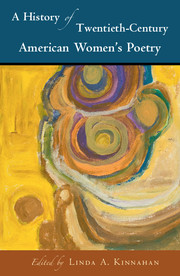Book contents
- Frontmatter
- Contents
- List of figures
- List of contributors
- Preface
- Acknowledgments
- PART I MAPPINGS AND CHRONOLOGIES
- PART II ETHNICITY, RACE, AND IDENTITY
- PART III MATERIAL FORMATIONS
- PART IV LINEAGES, TIES, AND CONNECTIONS
- 15 Token Women, Male Movements, and Literary History's Feminist Shadow
- 16 Lineages and Legacies: Real and Imagined
- 17 Crossing Geographies, Crossing Languages
- 18 Women's “spiritualities”
- PART V FORM, LANGUAGE, AND TEXT
- PART VI CODA
- Bibliography
- Index
17 - Crossing Geographies, Crossing Languages
from PART IV - LINEAGES, TIES, AND CONNECTIONS
Published online by Cambridge University Press: 05 June 2016
- Frontmatter
- Contents
- List of figures
- List of contributors
- Preface
- Acknowledgments
- PART I MAPPINGS AND CHRONOLOGIES
- PART II ETHNICITY, RACE, AND IDENTITY
- PART III MATERIAL FORMATIONS
- PART IV LINEAGES, TIES, AND CONNECTIONS
- 15 Token Women, Male Movements, and Literary History's Feminist Shadow
- 16 Lineages and Legacies: Real and Imagined
- 17 Crossing Geographies, Crossing Languages
- 18 Women's “spiritualities”
- PART V FORM, LANGUAGE, AND TEXT
- PART VI CODA
- Bibliography
- Index
Summary
The geopolitical landscape of the early twentieth century was one of dramatic change. A mass movement to cities brought with it new social phenomena such as the crowd, the streetscape, and the suburb. New technologies such as the airplane, the telephone, the camera, and cinema were making the orientation of the self to the world more dynamic, with new images and sounds encouraging innovative intertextual engagements with the “real.” Furthermore, as Rachel Potter suggests, “natural landscapes were disappearing and the geographical boundaries of nation states were redrawn.” Who and what was American, and the relationship of America to the world, was open to debate in light of complex, multidirectional flows of influence. As Ludwig Wittgenstein stated, “to imagine language means to imagine a form of life.” Deploying standard English in innovative ways or mobilizing other languages, dialects, or the vernacular helped generate new senses of belonging and hybridity. While writers like Mina Loy, Lola Ridge, and Baroness Elsa von Freytag-Loringhoven challenged origination narratives with their impact in America, many Americans would become expatriates, flocking to European cultural centers, most notably Paris. Yet there was also travel of the mind, with writers like Amy Lowell projecting their own image on places they would never physically see.
The early twentieth century saw a Western craze in “all things oriental.” Eunice Tietjens was assigned by Harriet Monroe to go to China and report back for Poetry, with the resulting collection of poems Profiles from China published in Poetry (1916) and as a book (1917). Amy Lowell reviewed them as minor “exercises in the Chinese manner, [rather] than … an intimate fusing of the author's ego with that of China.” Lowell's own fascination with the Far East was fueled by her elder brother Percival's travels to Japan and Korea. Lowell noted, “Every mail brought a constant stream of pictures, prints and kakemonos flowed in upon me, and I suppose affected my imagination, for in childhood the imagination is plastic … [Those representations] all through my childhood made Japan so vivid to my imagination that I cannot realize that I have never been there.” Lowell wrote of Japan in Can Grande's Castle (1918) and China in Pictures of the Floating World (1919) and Fir-Flower Tablets (1921). On the latter, she collaborated with Florence Ayscough, who wrote transliterations, with annotations of the various meanings of each word and her own analysis.
- Type
- Chapter
- Information
- A History of Twentieth-Century American Women's Poetry , pp. 274 - 288Publisher: Cambridge University PressPrint publication year: 2016



